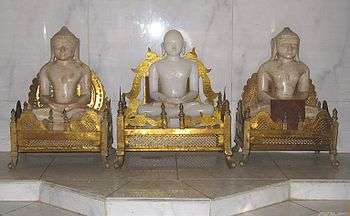Jivaraj Papriwal
Jivaraja Paprival was the installer of as many as 100,000 Jain images in the 15th century, now found in Jain temples all over India. He was a trader in the town of Modasa believed to be in Gujarat.[1] He was probably born in Surat, Gujarat.[2]
| Part of a series on |
| Jainism |
|---|
 |
|
Jain prayers |
|
Ethics |
|
Major sects |
|
Texts |
|
Festivals
|
|
|
India was overrun during the twelfth and thirteenth centuries by Turkish invaders. The two centuries following were a period of great devastation in North India. Temples were demolished and idols were defaced. These temple images had marked the tradition and identity of the Jain congregations, but few were left.
Paprival resolved that regardless of cost, and the fierce political climate he would find a way to install as many images of Lord Jina as may be needed by Jain communities residing in towns and villages situated anywhere in India. He commissioned teams of workers to cut slabs of marble from quarries and employed armies of craftsmen to carve the images.

A dedicatory Inscription of samvat 1548[3]
In 1491, Bhattaraka[4] Jinachandra Deva of Mula Sangh supervised a grand pratishtha or consecration of as many as 100,000 images.[5]
Jivaraja, with an enormous train of carts, then embarked on a pilgrimage to nearly all the Jain Tirthas of India. Braving the possibility of hostile confrontations with the invaders, wherever shravakas along the way lacked an idol he installed images.
Today the images can be seen in Punjab, Haryana, Bengal, Bihar, Bundelkhand, Rajasthan, Gujarat, Maharashtra and Karnataka,[6] installed by Jivaraja in temples of the Digambar and Shvetambar sects. Each statue is one to two feet high, composed mostly of white marble but with a few blue, black and green hues, and inscribed with a text mentioning Jivaraja Papdival.
One image was discovered during excavation in the Multan fort, which had a Jain population before the partition.[7] It was placed in a local temple. After the Partition of India it was left behind with a handful of Jains remaining. One of the persons saw in a dream that the image needs to be moved. Just as the image was being moved, the neighborhood was overtaken. It is now in Jaipur. Several images were found at Sammet Shikhar during an excavation in 2000.[8]
Today, in thousands of Jain communities all over India, the shravakas once again possess symbols of the faith thanks to Jivaraja's audacity and vision. Since then, the Indian state of Rajasthan has been the major carving center for Jain idols.
See also
References
- Jainism In Rajasthan, Kailash Chandra Jain, Jivaraj Jain Granthmala, 1963, p.78
- J. Gordon Melton; Martin Baumann (21 September 2010). Religions of the World: A Comprehensive Encyclopedia of Beliefs and Practices, 2nd Edition [6 volumes]. ABC-CLIO. pp. 2730–. ISBN 978-1-59884-204-3.
- Jain Shilalekh Samgah, Part 4, Ed. Vidyadhar Johrapurkar, 1961
- V. Johrapurkar, Bhattaraka Sampradaya, 1958.
- Y.K. Malaiya, "On the Shoulders of Giants" In Three Days' Journey into Self, YJA, Los Angeles, 2000.
- Announcement of Manikchand Panachand Award, Jain Mitra, VNS 2432 (1905CE), Year 7, No. 23, p. 304
- Multan Digamber Jain Samaj Ke Alok Me, Kastoorchand Kasliwal, Pub. Multan Digambar Jain Samaj, Delhi-Jaipur 1980, p.53-55
- Ahimsa Times, Vol. No. 01, August 2000